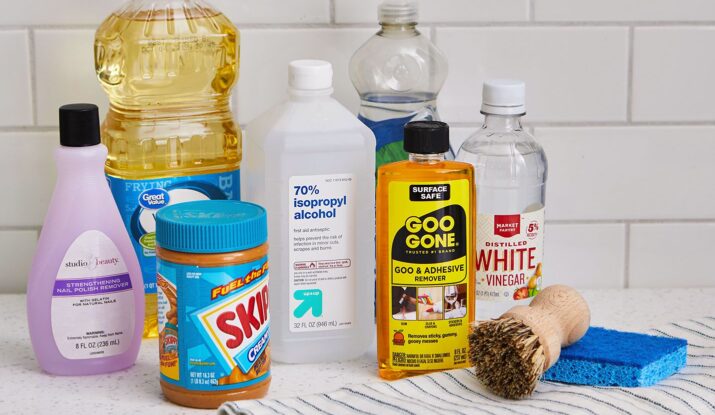Table of Contents
Super glue is great for making small fixes and detailed repairs, and removing adhesives can be just as straightforward. Despite being careful, glue can leave unsightly stains on clothes, tools, work areas, and other surfaces. Knowing how to clean up adhesive residue and which methods to use for different materials is essential for maintaining cleanliness. Urban9’s cleaning experts will assist you in discovering the most effective techniques for removing adhesive residue.
How to Remove Adhesive Residue: What You Need to Know
Using adhesives like super glues simplifies any project. However, removing unwanted residue, especially on large jobs, may require solvents or special techniques. Taking the right steps ensures your project is done correctly the first time. Here are some tips on the best ways to remove adhesive residue from common materials.
How to Remove Adhesive Residue: Methods and Materials
There are various techniques for removing residue, corresponding to the types of glue and adhesive. Generally, methods are classified into mechanical, chemical, or thermal approaches.
Removing Adhesive: Mechanical Approach
Many adhesive spills can be cleaned up with simple tools like plastic scrapers, paint scrapers, or razor blades. These tools use defined edges to trim away remnants. Use them gently to avoid scratching or damaging softer surfaces.
Removing Adhesive: Chemical Approach
Another method is applying a solvent that breaks down adhesive properties, allowing you to wipe the residue off. When choosing the best solvent to remove adhesive, consider the surface material and the required penetration level.
- Oil-based materials: Cooking oil, vegetable oil, peanut butter, or mayonnaise can work wonders. Apply, let it soak into the residue for about an hour, then wipe away.
- Rubbing alcohol or vodka: These solvents can handle tougher residue. Apply, let it permeate the unwanted residue, then rub away with a cloth.
- Commercial products: Many products are formulated to remove adhesive residue, but not every product suits all materials. Always read manufacturer instructions and test products on an inconspicuous spot first.
Removing Adhesive: Thermal Approach
Heat can weaken adhesives. Labels on wine bottles, for instance, can often be removed if heated. Use a hair dryer or bake bottles or other glass objects in the oven at a moderate temperature. However, be cautious, as glass can shatter at high temperatures.
How to Remove Adhesive from Metal
To eliminate adhesive residue from metal surfaces, start by using rubbing alcohol or isopropyl. Soak a cotton ball with the solution and apply it to the residue, allowing it to penetrate. Typically, most adhesives will dissolve upon contact without harming the metal. If this method is ineffective, consider using baby oil as an alternative.
How to Remove Adhesive from Plastic
Numerous solvents and strong chemicals can harm plastics. To safely remove residue, begin with warm, soapy water and scrub the area thoroughly. If this method fails, try using vinegar, which provides an effective clean without damaging the plastic.
How to Remove Adhesive from Wood
Sticker, label, and super glue residue can be quite stubborn on wood surfaces. To effectively remove such residue without harming the wood, consider these methods:
- Damp Cloth: Often, a damp cloth can be sufficient. For a deeper clean, add a small amount of detergent to the water. Be careful not to over-soak the wood to avoid swelling or warping.
- Heat Application: Use a blow dryer or a heat gun on a low setting. The heat will weaken the adhesive bond, allowing you to scrape off the residue with a card, scraper, or putty knife.
- Household Products: Items like white vinegar or vegetable oil can be effective. Soak a paper towel with the product and press it onto the residue for about five minutes. Gently peel away the loosened residue. Be cautious with oil on unfinished wood to prevent darkening.
- Commercial Glue Removers: Products containing citrus oil are particularly effective. Follow the manufacturer’s instructions when using these adhesive removers.
- Chemical Solvents: For tougher residues, consider using chemical solvents such as lighter fluid, paint thinner, acetone, or rubbing alcohol. Always test on a small area first and apply cautiously.
- Sanding: If all else fails, you may need to sand the wood. Start with 80-grit sandpaper to remove the residue, then smooth the area with 120-grit and 220-grit sandpaper. Refinishing or repainting may be necessary afterward.
How to Remove Adhesive from Glass
To remove adhesive residue from glass, acetone (commonly found in nail polish removers) is highly effective. Apply it to the affected area and gently rub; the residue should come off easily. If acetone proves ineffective, try using a small amount of spray lubricant, which can weaken the adhesive’s grip on the glass. Be sure to rinse off all the lubricant thoroughly afterward.
How to Remove Adhesive from Fabric
To get rid of adhesive residue from fabric and clothing, handle it delicately to prevent damage. Commercial stain removers are often highly effective. Thoroughly soak the area, let it sit for a while, and then wash it on a gentle cycle. If any residue remains, try applying detergent directly to the spot for spot cleaning. For more intense cleaning, use a diluted ammonia solution in hot water or an alcohol-based hand sanitizer. Always perform a test on a hidden area first to ensure it doesn’t harm the fabric.
Urban9 Cleaning Services is here to help you tackle stubborn adhesive residue on any surface with ease. If you find yourself struggling with sticky remnants or simply don’t have the time to handle it yourself, don’t hesitate to reach out to us. Not only will we expertly remove the adhesive residue, but we’ll also give your living space a refreshing makeover.

